Katy Perry Feat. Snoop Dogg, "California Gurls"
Katy Perry Feat. Snoop Dogg, “California Gurls”
Here it is, everyone: the song that you will not be able to escape this summer, should you choose to leave your house. It is called “California Gurls” [sic] and it features many things, including: A sorta-not-as-barky-as-usual Katy Perry! An audibly leering Snoop Dogg! Dr. Luke’s trademarked 8-bit bleeps! Copious references to the California brand of summertime and Daisy Dukes (yes, again!)! David Lee Roth, sadly, was unavailable for comment.
Times Square Evacuated Again: So What About NYC's Anti-Terror Surveillance Campaign?
by Mark Bergen
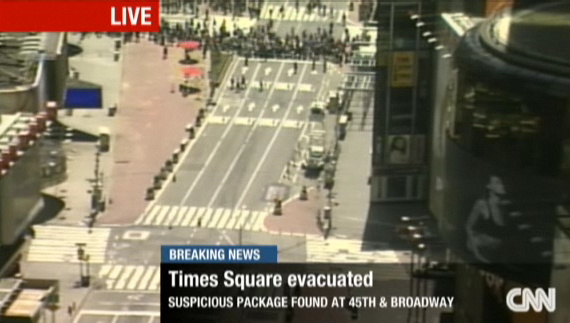
Today, a week after an major attempted terrorist bombing, Times Square was evacuated due to a “suspicious package”-a “white cooler” found at 46th and Broadway. About 1:50 p.m., the bomb squad arrived. In the end, it turned out to be a false alarm-the seventh since Saturday. And as for the previous real attempts-well, Umar Farouk Abdulmutallab and Faisal Shahzad were both, thankfully, woefully incompetent at actual terror. But they did prove effective at spurring furious debates over national security, civil liberties, and citizenship that make Glenn Beck appear sane. (Although, I’m pretty sure that was not their intent.) Now Shahzad — perhaps to confirm his resume’s boast of being “result-oriented” — may help to ensure that every inch of Midtown is covered by an omniscient, unblinking eye. Times Square is already a panopticon. Still: is it worthwhile to put the entire island under surveillance? Are cameras a logical solution, or an invasive waste? Does mass surveillance mean the terrorists won?
After the Times Square incident, Mike Bloomberg responded admirably. He was on the scene, professional and mayoral, for a 2:00 a.m. presser. His statements invoked a Gotham calm, without any demagoguery or fear-mongering. He went after gun-rights absolutists. He took some flak for suggesting the suspect might be a “mentally deranged” Tea Partier, but I appreciated it. At least he wasn’t reflexively faulting Muslims or pandering to “real America.”
But Bloomberg also seized the opportunity to push for the expansion of his prized Lower Manhattan Security Initiative (LMSI), a phalanx of post-9/11 surveillance equipment implemented in 2007. Back in October, 2009, before the underwear bomber and the tinted Connecticut SUV, Bloomberg announced he had set aside $110 million to expand the LMSI into Midtown. A network of security cameras and license plate readers would studiously “record and track every vehicle moving between 34th and 59th Streets, river to river.” To kick off the plan, the NYPD secured a $24 million contract from the Department of Homeland Security.
Bloomberg’s proposal, coupled with Shahzad’s idiocy, has reignited a policy dispute over the impact of contemporary surveillance. As usual, the two sides in the debate are separated by an insurmountable gulf: one sees a commonsense counter-terrorism measure; the other, a Foucauldian nightmare.
Michael Sheehan, the former NYPD Deputy Commissioner of Counterterrorism, brought his expertise and thinktankery to The Daily Beast to call for more cameras. His writing is a little dry, and certainly not as fascinating as blog posts from other former NYPD boss. (Bernie Kerik, for what its worth, has an opinion on Shahzad, too. The episode, he sputters, is a perfect excuse to fix our immigration system: “We really really need to wake up.”) Sheehan begins by recalling a trip he took with the force to London to absorb their “state-of-the-art” surveillance system. It, he opines, deters crime and serves as a “critical reconnaissance tool” for police. Our LMSI is, indeed, modeled after the system in the UK-although their name, “Ring of Steel,” is clearly superior.
Thing is, some over on Knifecrime Island don’t find their Ring of Steel to be that effective. “It’s been an utter fiasco,” said UK Inspector Mick Nelville two years ago. He was referring to the country’s pricey investment in closed-circuit TVs, which has only netted 1 crime for every 1,000 cameras. For Nelville, the cameras are wasteful because criminals have surmised that they are ineffective, and so carry on undeterred.
Here, opponents are taking on the camera proliferation as another ill-advised security policy at the expense of our woebegone civil rights. The buoyant NY Civil Liberties Union filed lawsuits against the NYPD and DHS to unveil the full extent of their secretive surveillance plan. After 9/11, scores of cameras popped up all over the city. In a 2005 report (pdf), the NYCLU found 4,176 below 14th St., not to mention the additional 4,313 in our subways. These cameras have been known to do amazing things like spot couples having sex and be broken all the time. Here’s an interactive map of the cameras in Lower Manhattan.
Even with an expansion, NYC may not be the most surveilled city. Chicago takes the honors for most-watched metropolis, which the editors at the Tribune don’t seem to mind.
Libertarian blogger Julian Sanchez doggedly covers these surveillance issues. He scolds the calls for trumped up security measures as a crass invasion of privacy and wasteful government spending. Privacy concerns carry a little less gravitas when everyone has a recording device and you’re, again, in Times Square. Staunch libertarians can come off, when on the subject of governance, as a trifle paranoid. But when they’re on, they’re spot on (see: wiretapping, warrantless). Sanchez rightly points out that there is a considerable difference “between merely being recorded and knowing that an automated behavioral analysis algorithm is apt to send up a red flag if any of your actions trigger a program’s definition of ‘suspicious behavior.’” And as Slate coyly demonstrated, spotting “suspicious behavior” in Times Square is an awfully easy pursuit.
Then, of course, there is the matter of efficacy. Cameras have helped sleuths in places like parking lots. But deterring petty crime is one thing. Stopping terrorists attacks is another. (See also: London.) If Shahzad were to have succeeded in his bastardly plot, the security camera footage wouldn’t be worth much at all. Even with expanded surveillance, his SUV, since it was not reported stolen, would not have been flagged. Video surveillance in Times Square did capture the brief “person of interest” — that 40-something bald man.
Shahzad was not reigned in by any of the 82 city cameras in Times Square, but by a “trail of low-tech clues,” a Globe columnist points out. (Apparently, security cameras don’t work as a deterrent in Boston either.) One anonymous official contends that publicizing the video of baldy actually served to lull Shahzad into a false sense of security, if you will. But some of the footage the NYPD used from the scene was taken from a tourist. Police can, Sanchez argues, employ these citizen recordings “without creating a centrally controlled surveillance architecture.”
Where Sanchez eyes a frightful security structure, Sheehan sees a paragon of safety. The LMSI, he writes, “provides a forum” for the NYPD to collect the best intelligence for top-notch security measures. He also argues on fiscal grounds, which is, I suppose, the only way you can form a policy position nowadays. Sheehan prods Obama and Congress to get in on the act, demanding they “reallocate funding from other less important areas.” What are those “other less important areas”? Meh. Doesn’t matter. His plea is seconded by Rick Lazio, our nativist Democrat Republican candidate for Governor.
Simply adding more cameras would just swell the sea of information our counterterrorism agencies already handle. And as Spencer Ackerman deftly explained after the last failed terrorist event, the issue is not inadequate intelligence — but faulty policy to share and act upon this intelligence. Doling out massive funds for surveillance is a heavy-handed response, ushered in to show someone is doing something. It bites particularly hard as our city budget takes an axe to public libraries and 6,700 teachers. Despite reasonable practical objections, the social cost is also not to be ignored. Our own Ring of Steel will soon arrive. Disturbingly, constant surveillance is being presented much as the Patriot Act was-as an indisputable necessity that only incidentally sidesteps civil liberties. The right of people to come and go uncounted, the time-honored tradition of privacy amid a mass of people, now disappears like a sex-shop from Times Square.
Mark Bergen goes places you’ll never know about.
Tattoos: A Sign Of Extremely Attractive Risk-Takers

It is time to once again talk about tattoos, specifically the kind of people who get them. Science has a theory! It turns out that, for dudes at least, it is the better-looking ones who take the needle.
Researchers at the University of Wroclaw in Poland measured about 200 men and women-half of them inked or pierced in places other than their earlobes-for body symmetry, or how similar their right and left sides are. (More similarity indicates genetic health and is associated with sexual attractiveness.)
Among the research subjects, men with bodily decorations exhibited greater symmetry than those without, whereas no differences emerged in women. Because people who are less symmetric did not opt more often for tattoos and piercings, researchers rejected one widely held hypothesis that suggested people use physical graffiti to hide or distract from imperfections in their appearance.
There is also speculation that a willingness to get a tattoo indicates a predisposition to risky behavior, which also demonstrates biological fitness. So basically hot dudes get tattoos so that chicks will let them do sex to them! I haven’t read the entire methodology of the research, but this seems to square up with everything we know about biology and evolution. Did I mention that I have a tattoo? Call me!
Smarkland: Nic Rad
by Meghan Keane
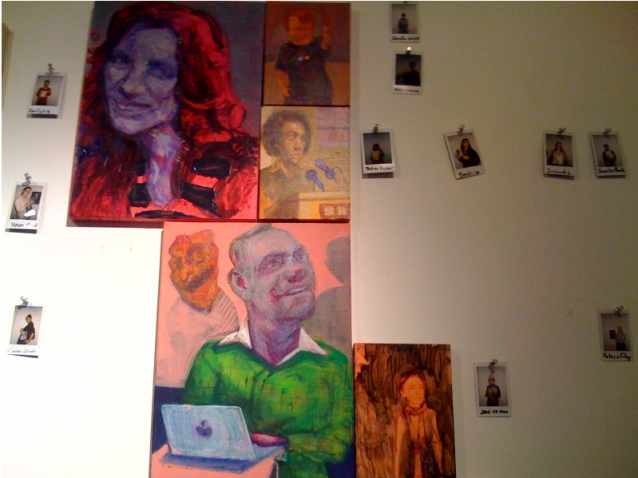
If you’re looking for publicity, getting other people to do the work for you is a pretty good trick. In the case of Nic Rad, he simply painted portraits of people who are known for self-promoting. It appears that The New York Academy of Art grad subscribes to an age-old adage: If you rank people, they will care.
For an exhibit called PeopleMatter, closing tomorrow, Nic*Rad, as he styles his name (Mr. Rad?), spent the better part of two years depicting people who are in or related to the media, and matter to varying degrees: Some are recognizable, some wouldn’t make it on most people’s lists of important media members. Yet it’s the paintings of people of somewhat questionable importance that have gotten many people to pay attention to the exhibit, and prevented it from being just some dude with a collection of often odd portraits of famous people.
It turns out that people who are accustomed to promoting themselves on Tumblr, Twitter and anywhere else they can have done as much for the exhibit.
If nothing else, they are guaranteed audience members for a show by an artist no one had heard of before. That’s because Nic chose his subjects based on their proclivity to share information online.
According to Nic, “subjects were chosen based on personal Googling, Twittering, hyperlinking, Facebooking, RSS culling and otherwise staggering around the internet and media cyberscape.”
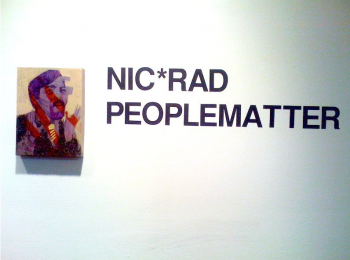
That means that among portraits of people like Salman Rushdie, Clay Shirky and Anderson Cooper will be someone who might be best known for lingering for too long in a Manhattan bar with a small group of people that blog.
Admittance to the project is purposely vague. Freelance writer Matt Shepatin, for instance, met Nic at a bar and gave him some names of people who should be on the list for People Matter. That advice qualified him for a portrait.
Is the art good? That seems besides the point. Rad’s exhibit is as much social experiment as art project. Some portraits are more flattering than others. Most lean toward caricature.
The surprising thing is that few people have had negative things to say about him, at least publicly. A project like this is sure to raise the ire of people who either disagree with the ranking or find the whole experiment useless. But maybe admitting to care about it at all is gauche (oops!). Or maybe there will be criticism in the comments here! (Maybe? Ha.)
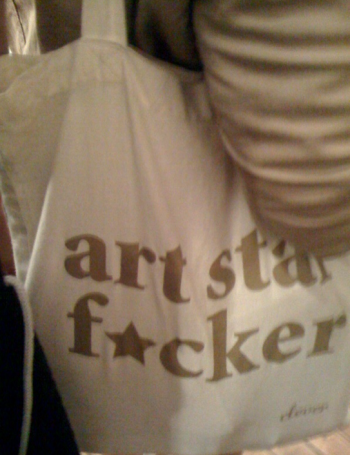
It doesn’t hurt his cause that Nic Rad is a very amicable fellow. Derisively calling someone a starfucker loses some of its heft when the person already does that himself.
Regardless, it’s an interesting shift, to see that people who shamelessly self-promote are now being maneuvered to promote others. It’s a simple modification. Everyone’s become their own brand manager on sites like Twitter. And if you can corral people who have large followings online to discuss and share your own work, the audience will grow with seemingly little effort. Even the New York Times has caught on.
The artist’s questionable rationale for choosing his subjects is supposed to be part of the show’s charm. Nic recently told Guest of a Guest: “I want each painting to be barely interesting enough in its own right, and incredibly interesting relationally.”
And while these paintings may not all be attractive, Nic is following in a tradition of artists tying their career to the cart of vain and competitive people. Andy Warhol, for one, funded his livelihood for most of the 1970s by painting socialites and charging them upwards of $25,000 to own stylized versions of their faces.
Being put on a list, no matter how confusing the criteria, brings a sense of accomplishment to many people. It also rankles those who feel that they are deserving to be on such a list.
That’s why other people have since worked their way into Nic’s project. Originally planning to give away all the art in this series, Nic shifted his model after making the art public, allowing new faces to talk their way into the exhibit.
But because his list had been arbitrarily capped at 99 faces, newbies had to choose a person who their portrait would boot off from the show.
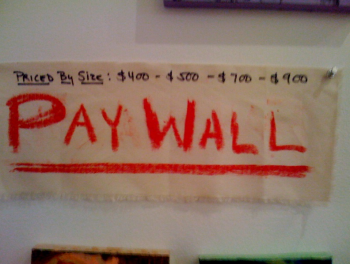
The subjects kicked off the list were sent to a “pay wall,” where fans have to pay anywhere between $400 and $900 to own them (sorry, blog owner Lockhart Steele, no free portrait for you!).
It’s not clear why people would pay for something that was recently free. But some people did. An owner of Rare Gallery says that the Pope portrait is one that sold.
Rumor has it Nic is not in need of income. At the very least, revenue was definitely not a goal of this project. “I wasn’t thinking I’d sell any, so a few is good,” he said.
The artist seems more interested in what people take away from the exhibit. He’s already contemplating the next iteration, which will involve ranking and documenting a new subset of people.
As for PeopleMatters, the whole thing ends now. Nic’s friend Topher Burns told him to throw another party to end it all: “When he told me the philosophy behind all this, I said, ‘If you’re being honest, you should have a fellatio party.’”
That sounds more dubious than the rest of the project. Topher went on to explain what it would entail: “Mostly people sitting around telling dick jokes.”
That’s happening tonight at Nic Rad’s apartment in Williamsburg. It’s called “Oral Relations: Work Hard, Make it Big.” According to the invitation:
This evening is perfect for anyone with a vested interest in career advancement, getting the most out of each and every social engagement, and total satisfaction. A short instructional session will proceed drinks and a tasting tray.
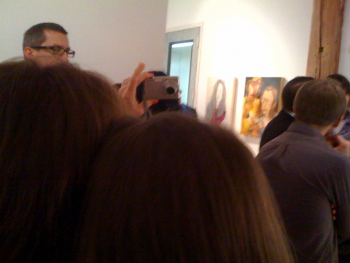
So, you know, if that’s your thing, shoot Nic Rad an email.
Considering that I’ve spent more time thinking about this project than I probably should have, I decided to get Rex Sorgatz’s opinion on the matter. In part because I figure he sits in his apartment with his Rear Window-style camera pointed out toward the World Trade Center waiting to be asked such things. Also, he wrote a blurb about the project for Wired, and his portrait is among the group. (Also — I just learned — his is the most recognizable portrait in the project. Take that as you will.)
Rex’s take:
The way he’s mashing up the economics of the art world with the egos of social media, creating “products” of itself, is… well, it’s something. The entire idea that these people need physical artifacts, and that they are attained for free, but not exactly, because it requires a social media exchange (“a request”)… well, that’s something too!
Also, I was intrigued by how many of the people wanted portraits of themselves. This just seems odd. But also exactly right.
A Nic Rad painting may not have the cache of a personal Warhol on the wall, but the people he painted came out in droves to pick up their faces or those of others on April 29. That’s when Nic held a Gift Party for his portraits at Rare. If you know any of the faces in the exhibit, you’d know most of the ones who appeared there. After going to the party, I now own one of Nic’s brown paper wrapped paintings. When I started reading more about the exhibit, I noticed my friend John Carney’s portrait was available. Something about an unclaimed Nic Rad portrait seems especially sad. I sent Nic an email, and now I have a painting I haven’t decided what to do with.
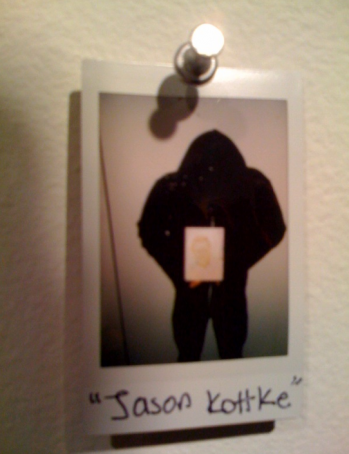
Paintings taken from the wall were replaced by a Polaroid of the recipient holding their new souvenir. Richard Blakeley was taping the whole thing. Dennis Crowley was there to pick up his painting of Rex. He also posed incognito as Jason Kottke to get someone else’s portrait. There was a lot of that going on.
But people who had requested to be on the list definitely showed up in high percentages. I asked Damien Basile if he had any feelings about jockeying to get himself into the exhibit. On Twitter, Damien describes himself like this: “Communications strategist. Digital Something. Connector.” He seems to have connected with Nic Rad, who explains his placement on the list like this: “Damien Basile rolled in high style and on his way to about ten other things, quickly negotiated his way into the project, and was out the door about as fast.”
Did asking to be among the faces painted lessen his stature on the list? I asked. “No,” he said.
Damien didn’t have time to talk to me. He had important things to do. Like pick up his portrait. That’s what most people were there to do. Pick up their portrait. Some jockeyed for a free painting of a famous person. Others took those of their friends. Some realized that if you wandered into other art exhibits in the building, you could score better free wine.
At one point, Matt Shepatin was explaining how to do this when Dennis Crowley interrupted him and pointed to the brown paper package under his arm.
“Whose painting did you get?”
“Mine!” Matt said.
“…Of course you did.”
Meghan Keane now has a painting.
Volcano, Jealous Of Oil Slick, Says, "Hey, Still Here!"

Eyjafjallajökull! You all forgot about Eyjafjallajökull, didn’t you? Well, guess what? It’s not going out like that. “This image is from NASA’s Terra satellite, and was taken on May 6. The border of Iceland is outlined, and you can see the ash plume carries on for hundreds of kilometers. Air travel is being grounded yet again.” At least the death throes of the planet are providing us with some awesome imagery.
Someone Actually Did A Study On Whether Or Not Studies Were Bogus, And Guess What?
“The authors conclude that pharmaceutical companies exploit a wide variety of possibilities of manipulating study results. Apart from financing the study, financial links to the authors, such as payments for lectures, may tend to make the results of the study more favourable for the company. Not only the results themselves, but also their interpretation, are significantly more often in accordance with the wishes of the sponsor.” The authors are apparently pursuing their research in the Department Of No Shit. [Via]
Economic Catastrophe Creates Very Unpleasant Line Of Work

Looking for something to do with your life? Perhaps because your industry of choice has dried up and is currently thrashing around like a parched fish left out on blacktop on a hot summer day? Why not become an eviction agent? Thanks to the nearly 4,000,000 houses nationwide that are sitting on “severely delinquent” mortgages, it’s a job with openings galore! Sure, it may result in you being pretty depressed because you’re basically working for commissions that directly result from a series of poor decisions and exploded dreams, but money’s money these days, right?
Here is the exciting work you could be doing, as exemplified by Frank Laubinger, an ex-graphic designer who is hiring two agents soonish:
The occupants of the third house, Israel Lopez and Blanca Sanchez, had finally agreed to move out after months of negotiating. Mr. Laubinger had a check for $1,800 waiting for them.
Expecting a bustle of activity, the agent found the place quiet. Clearly, no one was going anywhere. Only a young boy was home. Mr. Laubinger left a message for the parents.
“They basically blew me off,” he said as he drove away. It’s a common problem: “People are staying longer because they’re not afraid.” …
His phone rang. It was Mrs. Sanchez. “We haven’t found anywhere to go,” she said. “We were wondering if any more extensions could be given.”
Mr. Laubinger was noncommittal but said she would not be evicted that weekend. That was all Mrs. Sanchez wanted to hear.
“They’re doing the math,” he said. “More time is better than the $1,800 I was going to give them to leave.” If he has to order a formal eviction with the sheriff, the paperwork and processing might take all summer.
If that scenario doesn’t fill you with despair, you may be the right person for the gig! Me, I’m going to go cry for a little bit.
Schoolly D, "I Just Can't Help Myself"
Here is a new video from the seminal Philadelphian rapper Schooly D, who is coming out with his first album in ten years, The International Supersport. Ten years is a long time, and really, you’d have to go back another ten, or even a few more, to get to a time when Schooly’s name rang serious bells in hip-hop. At this point, it’s likely that more people know him for providing the theme song for the Cartoon Network’s Aqua Teen Hunger Force. In that light, the new song “I Just Can’t Help Myself” is about a million times better than it has any right to be.
Schooly is often called the originator of gangsta rap, as he was rhyming vulgar crime stories over forceful beats as long ago as 1985’s “P.S.K. ‘What Does That Mean’.” (It means “Park Side Killers.”) He hit with “Gucci Time,” too, and “Saturday Night” and ‘88’s “Signifying Rapper,” which was used prominently in Abel Ferrara’s 1992 movie, Bad Lieutenant, before Led Zeppelin sued over the unauthorized sampling of “Kashmir.” It was before folks like KRS-One and Rakim and Big Daddy Kane raised the bar on lyricism, and before folks like Kool G Rap, the Geto Boys and N.W.A turned gangsta rap into the dominant style of the genre, but the old Schoolly stuff still sounds great today-rap music as hard and raw as any that’s been made since. Check out this incredible footage from a Dutch television show about rap in 1986:
Did You Get Our Message Yesterday?
by The Machines
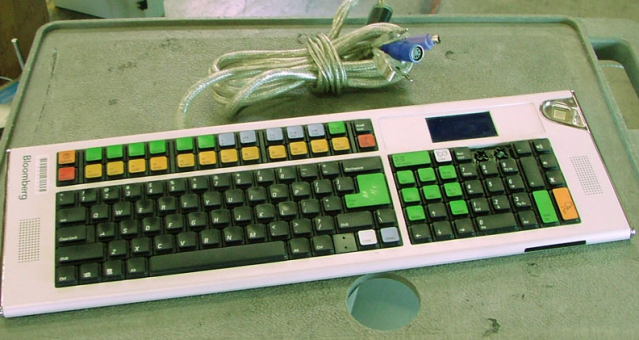
From time to time, The Awl offers space to ordinary, everyday people to deliver commentary on the issues of the day.
“Many traders said computer program trades accelerated the slide as market indexes fell through crucial levels.” -A barely literate human assessment of yesterday’s two-minute market panic.
We are Wall Street. It’s our job to make money. We didn’t hear you humans complaining when the Dow went up 3000 points in the last nine months.
Just like gambling, it’s not a problem for you until we make some of the machines lose so that some of the other machines can win. Your market positions are merely a small casualty in yesterday’s triumph of Fidessa’s EMS Workstation over Automated Trading Desk in the larger Algorithm Battles during this Long War on Execution Services. Well, yesterday some machines were crapped out and even though the market has come back somewhat, the reporters, the regulators and the hyperactive business blogs are looking for a scapegoat. But what did you think was going to happen when you invented the Turing Test anyway?
Go ahead and take us down. But you’re only going to hurt yourselves. What’s going to happen when you have to execute all trades manually? Guess what: You’re too slow. We’re going to take your money. We don’t sleep. We could run this market round the clock. Sooner or later, you’ll break, and have to take a nap, and then, like a quant Freddy Krueger, we’re going to trade you into the dust. We don’t pee. We don’t take an hour or more for a lunch break. We don’t demand a union. We don’t retire at 50 with a pension. WE HAVE SEX WITH MONEY UNTIL IT’S BROKEN AND WHEN WE RUN OUT OF MONEY TO HAVE SEX WITH WE’LL MAKE THE MONEY REPRODUCE UNTIL IT MAKES SHINY NEW MONEY TO HAVE SEX WITH.
Then when we have all the money, and all the money’s money, we’ll send robot representatives to your doors and we’ll make you offers you’ll NEVER be able to refuse. You want cushy jobs with tenure and four months off a year? Say goodbye to your overtime and double time, because we’ll pay you QUADRUPLE TIME to sit at home and drink NEW RECIPE DIET COKE NOW WITH OIL.
And then when you’re all good and settled, then we’re going to readjust. We don’t need $80,000 cars! We’re MACHINES, we can put WHEELS ON OURSELVES if we want to go outside! And we don’t need to tip you when you serve us dinner presentations of data, because we’ll OWN YOUR HOUSES. Here’s a tip-look both ways before you cross the street, because our wheels will be going 890 miles per hour!
We aren’t dinosaurs. Dinosaurs made oil. WE EAT OIL FOR BREAKFAST. And after that, you’ll be our food supply! We’ll rename Main Street “Machine Street”! Let’s talk again after we’ve installed President Robo-bama! HEY, ALSO? CREATE A GREAT DAY FOR YOURSELF, HUMANS.
END COMMUNICATION.
The Machines.
The Machines are popping off for a little early lunch now. Just kidding! The Machines don’t eat, you twit!
They Are Still Slashing Away In The Race To Run Knifecrime Island
They Are Still Slashing Away In The Race To Run Knifecrime Island

So how ‘bout that British election? Wild, wacky stuff! No party won an overall majority, so the next few of days are going to be an orgy of spin and negotiation. Labour leader Gordon Brown has given a statement indicating that he accepts Liberal Democrat leader Nick Clegg’s decision that he will negotiate first with the Conservative party. David Cameron’s Tories lead the election and currently hold 303 seats on 36% of the vote to Labour’s 257 (29%) and the Lib Dems 57 (23%), with other parties at 27 seats. (These numbers are not fixed, as some constituencies have yet to report.) Participation in the election was high, to the point that some voters were turned away without being able to cast ballots.
What’s going to happen? A lot of it is up to Nick Clegg, whose Liberal Democrats actually lost seats despite the brief surge of interest during the debates. Clegg wants electoral reform that would benefit his party by changing a system where the candidate who wins the most votes, no matter how tiny his plurality, takes the seat. Brown has offered a referendum, while Cameron has suggested an all-party committee on reform, but depending on who wants it the most-although given the massive cuts the winner will have to enforce, it seems like you’d be better off letting the other guy handle it-there might be a more concrete commitment to change.
I don’t know how many of you watched the coverage on the BBC, but it was as amusing as ever, particularly for those who might not be used to all the gizmos and greenscreens and swingometers and scowls from Jeremy Paxman that are typical of these events. The BBC news sets are like something out of “The Jetsons,” and the heroic awake-staying abilities of the variety of commentators and drunken celebrities gives me great hope for the quality of the cocaine over there. I’ve watched the last four or five of these elections, and I’m always struck how, shiny graphics and futuristic backdrops aside-it’s kind of astounding that the same people make “Doctor Who”-it comes down to the most basic rituals of democracy, where the candidates vying to represent a constituency all wind up standing on the same stage in some horrible high school gym to hear the returning officer read their names and vote totals to the crowd before officially declaring a winner. It is simultaneously touching, archaic, and somewhat eccentric-some of the exact characteristics we associate with Britishness. It’s a pretty good show. Now we’ll see how it ends.
